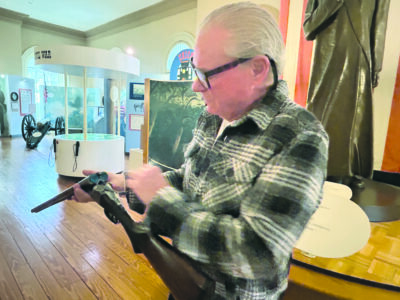Builder of Suspension Bridge Remembered on W.Va. Day

WHEELING — West Virginia Day on June 20 normally abounds with red, white and blue celebrations, cannons firing, re-enactors making speeches and birthday cake.
This year, the cannons remain silent and there is no cake or patriotic ribbons due to the need to continue our diligence in tamping down the COVID-19 outbreak. However, this weekend we remember civil engineer Charles Ellet Jr., who is known locally for the design and construction of the Wheeling Suspension Bridge in 1849.
This weekend marks the 158th anniversary of his death.
Older than the state itself, the Wheeling Suspension Bridge was the longest suspended span at 1,010 feet at that time. It crossed the Ohio River between downtown Wheeling and Wheeling Island. It remains the oldest such span in the country.
The famed bridge withstood damage from errant river boat pilots whose steamboat stacks struck the bridge much to Ellet’s dismay. Then in May 1854, the Suspension Bridge collapsed during a windstorm. Immediately Ellet set out to rebuild the bridge. He was challenged with a court injunction to forgo the repairs and went ahead anyway to bring the bridge back into operation.
Jump ahead to 2020, and Ellet would most likely seek answers to the structural issues that have caused the span to be closed to vehicular traffic since the fall of 2019. Instead of steamboats, Ellet would have faced the effects of tour buses and oversized trucks that have led to the bridge’s semi-retirement.
Ellet, a resident of Lynchburg, Virginia, was proliferant in mathematics. He was born Jan. 1, 1810 in Penn’s Manor, Pennsylvania. He was raised and educated in Bristol, Pennsylvania.
Ellet proved to be brilliant in the field of math, even as a teen. He studied engineering in Europe and brought his knowledge back to his homeland. It was in France that he acquired the knowledge to construct suspended bridges with its intricate cable system.
Ellet was married in 1840 to Elvira Augusta Stuart. They had four children, Mary Virginia, Charles Rivers, Cornelia Daniel, and William Ellet.
He assisted in the planning, design and construction of the Lynchburg and Tye River division of the James and Kanawha River Canal. In 1841, he was contracted to build the first permanent suspension bridge in America — the Schuylkill River Bridge at Philadelphia. In 1847, he was tasked with planning and overseeing the construction of the Wheeling Suspension Bridge. With each project, Ellet moved his family to be with him. He found Wheeling’s air quality somewhat unhealthy and moved his family to a country location east of Elm Grove.
Yet, building bridges was not the only element of fame in Ellet’s storied life. His engineering abilities and experience with the Central Railroad of Virginia, caught the attention of the war department. He was tagged to perform surveys and studies for plans to protect the delta of the Mississippi River.
As the Civil War between the states broke out, Ellet saw the need for a steam-powered ship for the Union forces to ram the Confederates on the Mississippi River. He was commissioned to purchase such ships and convert them into rams. He led a fleet of nine rams in the Battle of Memphis. His skills proved victorious for the Union. However, Colonel Ellet was fatally wounded. He died at Cairo, Illinois on June 21, 1862. His body was taken to Independence Hall in Philadelphia where it would lie in state beneath the Liberty Bell. Ellet was given a large military funeral and was buried in the family plot at Laurel Hill Cemetery. It was reported that his wife died just days later of a broken heart and was buried alongside her husband.
In 1938, the USS Ellet, a 1,500-ton destroyer was named in honor of the five members of the Ellet family who distinguished themselves in the Civil War.
Portions of this article were from the writings of historian John Bowman.




